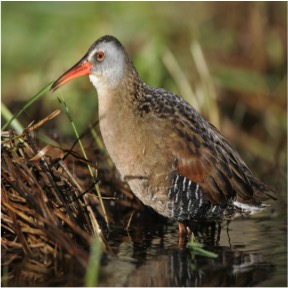Tamworth–April 17, 2019–Virginia rails occupy shallow freshwater wetlands with tall stands of cattails and rushes. They need areas with standing water typically less than six-inches deep, with a muddy bottom.
These 8-to-10-inch rails are most common in wetlands with 40-70% coverage of tall emergent vegetation, mixed with open water, mudflats, and areas with matted plant debris. Such a place is the ASNH Thompson Wildlife Sanctuary in Sandwich, where they might be found arriving in mid-April. Then they will start setting up breeding territories even if these odd solitary birds are difficult for us to determine that they are here.
Mostly they are heard rather than seen with their loud grunting sounds, especially in spring, which is still the best time to find them. Rails are famously secretive.

They will build a nest on floating mats of vegetation at or just above the water’s surface. Males and females loosely weave plant material together to form a basket. Sometimes they often weave it from above to create a canopy over this nest. That construction can take a week. The clutch size will be 4-to-13 whitish eggs with sparse irregular gray or brown spots, and they can raise 2 broods.
Virginia rails eat beetles, snails, spiders, flies, small fish, slugs, crayfish, and frogs. They probe their long, reddish bills below the surface of muddy and silty-bottomed wetlands for prey, typically at dawn and dusk. These pale rusty rails have strong legs with big leg muscles and exaggerated, long toes that help them walk and run on these floating mats of wetland vegetation.
Virginia rails are said to have forehead feathers adapted to withstand constant probing for food and moving through wetland stems. They have a very thin body that helps them sneak through multiple stems in their impenetrable wetland habitat. Virginia rails make abrupt movements, flicking their tails as they walk, and they tend to seek cover most of the time. They may dive underwater and swim across a wetland’s open areas on occasion. Sustained flight only occurs during migration.
To see one, look for breaks in their dense habitat, such as places where a channel creates an opening. Or perhaps, a mudflat next to patches of cattails or bulrushes where they might furtively forage briefly in the open. To see one of these birds, you have to think like a rail!
Dave Eastman broadcasts “Country Ecology” four times weekly over WMWV 93.5 FM. As Vice President of the Lakes Region Chapter/ASNH, he welcomes you to monthly programs at the Loon Center in Moultonborough. He is available at: cebirdman@yahoo.com (or) www.countryecology.com for consultation.
